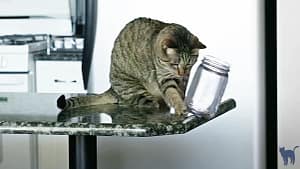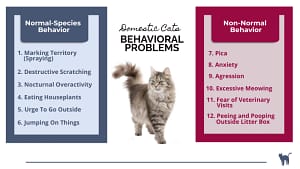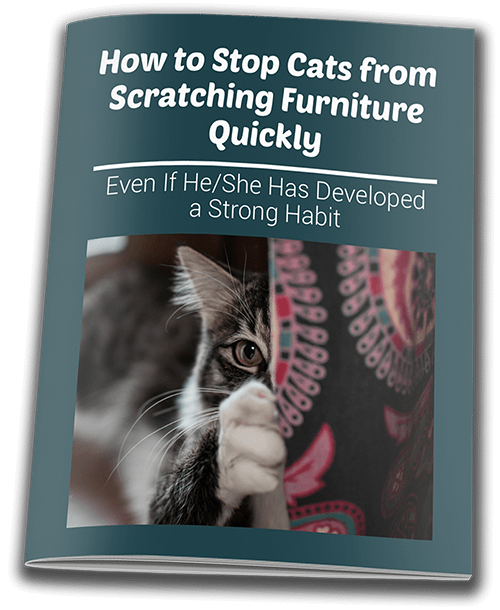Cats could grab your hand and bite it because:
- They want to play and think your hand is a toy;
- They may feel annoyed and overstimulated by petting;
- They have been harmed while being groomed, and
- They may have an injury.
Based on the context, you can determine which of these reasons made your pet bite your hand.
Cats do unexpected things we hardly understand. Yet, those behaviors are not accidental or random.
What happens is that cat owners haven’t yet learned to understand how cats act. This is why their behavior raises so many questions.
In this article, I go into great detail to answer one of the most common questions that cat owners have: why does my cat grab my hand and bite me?
This annoying behavior could not be related only to petting. I’m sure that by reading this article you’ll be able to understand your feline friend a little better.
So, keep reading.
Why Does My Cat Grab My Hand and Bite Me? (long answer)
First, we need to make a clear distinction between cats and kittens.
Why?
Because cats and kittens bite for different reasons. Understanding each case can help you find out how to stop the biting.
A kitten bites because of a lack of socialization. They are still learning how to express themselves the right way.

Kittens learn good manners by interacting with their mother and other kittens. When placing a kitten in a new home, there is a high chance they’ll start biting. This is because they haven’t learned yet how to behave well.
Kittens don’t understand that teeth and claws hurt. Thus, their owners must explain it to them in kitty language. Just like a mother would.
An adult cat, instead, will bite as a way to get what it wants. If it still does it, it probably means that it has not learned the proper behavior from a young age.
The first step in putting a stop to this behavior is to figure out why they’re biting. While researching for this article, I found out 4 main reasons why he or she might grab and bite your hand:
- Your cat wants to play with you and considers your hand a toy.
- When you pet your cat, it becomes irritated and overstimulated.
- Your cat is not pleased with the grooming session (may even feel pain).
- Your cat could be hurt and react as a sign of threat.
These bites are not aggressive because they do not show hostile responses like hissing or growling.
You may also notice that your pet uses these behaviors interchangeably with a meow. And some cats may bite when they are hungry or trying to get your attention.
Let’s look at each case in detail.
# 1 Your Cat Wants to Play With You and Considers Your Hand to Be a Toy
Biting is a normal kitten play behavior. They develop their biting habits early in life and do it as a form of play and affection.
This is their way of communicating with other kittens since they cannot speak. Also, they bite to mimic their hunting behavior, and your hand is an easy target.
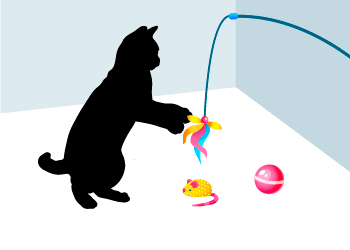
Cat owners must teach kittens to only bite toys. Avoid the temptation to allow kittens to:
- chase them,
- jump up on them, and
- chew on their fingers, hands, arms, or feet while they are still young.
If you have allowed your kitten to use your hand as a toy since adoption, he won’t understand why this behavior is inappropriate.
Many cat owners think that playing with their hands is acceptable. While it may be cute and safe for a kitten to bite your hand, it won’t be as it grows into an adult.
The truth is that you are promoting future bad behavior.
The same is true for playing time. If you allow your feline friend to bite your hand during playtime, it will keep doing it, no matter the context.
The rule is simple: cats’ teeth should NEVER interact with you.
These gentle bites are referred to as “love bites.” These are the bites that feel more like their teeth have been placed around you than an actual bite.
But in some contexts, they can be more intense and painful.
When this happens, the bites are usually not aggressive or continuous.

Your pet is just trying to get your attention, maybe because it wants to play and have fun with you.
Perhaps now you’re thinking:
OK, I get it, I let my cat play with my hand… I made a mistake, but what can I do now?
Don’t worry.
The answer is easy: you must direct your cat’s attention to a toy.
Set aside time each day to play with him or her. While doing so, provide it with toys to play with when it’s alone. Catnip-filled and tower of track toys are two excellent toy suggestions.
Catnip toys are particularly useful because your pet can grab and bite them instead of your hand. Also, they’ll keep your pet entertained while you are away.
I’ll show you how to do it later in this article.
# 2 Your Cat Is Annoyed and Overstimulated When You Are Petting It
“Biting owners during petting is one of the most common behavioral problems in cats”, says Dr. Kelly Ballantyne, a board-certified veterinary behaviorist at the University of Illinois.
Cats like to be touched, but only to a certain extent, on its terms, and in specific places. Do not assume that cats enjoy being petted for long periods because you may upset them.
When you pet your cat over and over again in the same areas, you are setting up a perfect recipe for overstimulation. In fact, cats have a sympathetic nervous system that, when overloaded by petting, causes them to bite.
Most cats will wrap their paw around your hand and grab it as a sign that they’ve had enough of petting. They might be trying to tell you they don’t want to be stroked, or perhaps it is not right now or not in that area of their body.
Some cats can be fickle, wanting attention one minute and then changing their mind the next. The key is to pay attention to their body language.
- What do they do when they become irritated?
- How do they look when they’re about to bite you?
- Do they always bite you if you touch their stomach, tail, or feet?
Since cats can’t speak, we can’t blame them for communicating in that way. On the same note, we can’t keep letting them bite us…
Meaning that it’s up to us to work with them rather than against them.
For starters, respect your cat’s boundaries once you’ve noticed the signs that he or she doesn’t want to be touched. Otherwise, you’ll only irritate it.
Remember that not all cats enjoy petting sessions. Some prefer relaxing on their parents’ laps, for example.
Does your cat bite you during petting sessions, even if it likes to be petted?
You may be touching sensitive areas of its body, such as its belly or tail.
This may require some trial and error. Cats are typically very communicative when they want (or do not want) something. So knowing what they want is easy (purring vs hissing).
Do you want to know more about this topic? Does your cat nibble you when you pet it? then look no further, this article is for you:
Why Does My Cat Nibble Me When I Pet Her or Him? [Here’re 5 Ways to Avoid That]
# 3 Your Cat Doesn’t Enjoy the Grooming Session (May Even Feel Pain)
If your cat grabs your hand and bites you while grooming, this can become a major issue.
As you probably know, trimming cats’ claws and brushing them are things you should do regularly.
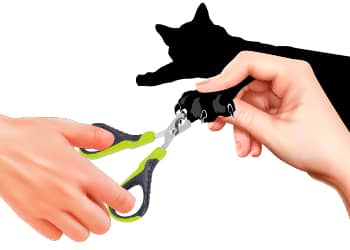
So finding out why your furry friend dislikes being groomed is important.
Most of the time, such a reaction stems from fear. If your cat shows any signs of discomfort, stop brushing it before it becomes agitated.
The first step is to ensure that you are not harming your pet.
- Do you know how to trim a cat’s nails properly? If you don’t, you could be causing them a lot of pain. The same is true when browsing long-haired cats.
- Do you brush your cat regularly? If you don’t, your pet will have knots, tangles, and even mats. These irritate its skin and make combing painful.
It’s no surprise your cat is biting and trying to escape!
You need to learn how to groom your cat without injuring them. This means that you should take extra care when grooming it so to avoid hurting it, as it takes time to regain your cat’s trust. Remember to stay calm and patient throughout the process.
If you are sure you’re not hurting them and they’re just being fussy, try spreading grooming time throughout the day. Brush your pet until you can feel he’s had enough of you. Keep an eye on his tolerance though.
If your pet only tolerates brushing for one minute, start with 30 seconds and increase gradually. Speak in soothing tones and reward it for its efforts with a treat or catnip.
And if you’re not confident in your abilities, hire a professional groomer to take care of your cat’s grooming needs.
# 4 Your Cat May Have an Injury
Is your feline friend biting you unexpectedly, and it isn’t normal behavior?
If this is the case, examine your cat’s body before having a bad reaction.

Consider that they may have been injured or become ill as a result of a catfight or other people’s pets.
Though this is more common in older cats (joint pain in most cases), it can happen at any age. Look closely at him or her for signs of cuts, limping, or other visible injuries.
If your cat’s behavior changes, as it does from time to time, take it to the vet for a thorough check-up and treatment.
How to Train Your Cat Not to Bite
There are some techniques you can try. You’ll have to tailor your response depending on:
- Your cat’s age (adult vs. kitten) and
- The reason for the biting.
While a cat owner may think a bite came out of nowhere, the action is justified from a feline perspective. So, even if your pet is only acting out of love, his or her behavior can become quite irritating.
So how to stop your cat from biting again?
Here are three suggestions you can take to avoid non-aggressive biting in the future:
- Educate yourself on your cat’s warning signs;
- Introduce a playtime routine with your cat;
- Re-educate your cat to ignore your hand.
Let’s take a closer look at each one:
# 1 Educate Yourself on Your Cat’s Warning Signs
First, beware of your cat’s behavior, body language, and facial expressions. Understanding when and why your cat bites is a critical step in preventing this bad behavior.
Thus, start paying attention to the signals your pet shows just before a bite. Most of them exhibit the following signs:
- Swish or flick their tail before biting;
- Ears flatten abruptly;
Pupils dilate fast or shrink suddenly; - Cat’s back hair begins to stand up;
- Before attacking, it vocalizes or hisses.

Respect these intentional signals if you see them! Stop whatever you’re doing with your furry friend immediately.
Remember that if your cat bites you hard enough to make you bleed, you should wash the wound as soon as possible to avoid infections.
# 2 Introduce a Playtime Routine With Your Cat
Most of the time cats that grab and bite your hand are just trying to mimic hunting behavior. Playing with your pet is a safer way to stimulate hunting instincts.
When a cat catches prey, it would tear it apart by biting and scratching at it. And that’s exactly what happens if you let it play with your hand. Your feline friend is doing what comes naturally to it.
Fortunately, there are better ways to emulate your cat’s hunting instincts. One way is having playtime without using your hand.
So let’s break down a constructive playtime:

Playtime Duration
To keep your cats healthy and active, you should play with them for 30-45 minutes every day. Playtime should be divided into 10-15 minutes, as your pet is unlikely to play for half an hour straight.
Playtime Schedule
How to Get Your Cat to Ignore Your Hand
Wand toys with feathers at the end are the best option. They move like a bird, worm, or other animals a cat usually hunts.
They are ideal since they mimic the way their prey moves and also keep your body at a safe distance. In short, two birds with one stone.
Remote toys are another excellent tool. It can range from things that stimulate the eyes, such as laser pointers, to things that wrinkle and make a small noise. What makes them great is that you can carry them in your pocket.
So…
What’s the goal of playing with your cat? While it may seem strange, the goal is to tire them out.
You don’t know how to play with your pet? Believe it or not, this is normal among many cat owners.
You can use a technique called “boil and simmer” taught by Jackson Galaxy, a well-known expert cat behaviorist. That means simulating a real hunting session.
Here’s the drill:
- Show your pet the “prey”.
- Stimulate him to visualize it.
- Hide it behind furniture (or anything else).
- Then let your cat follow the toy, so it can catch it.
- Finally, repeat the process two or three times until he feels tired.
You should also leave more toys around the house that your pet can play with alone. There should be at least three available, like these:
Stuffed animals: most cats’ favorite.


Tower tracks toys: another perfect option to keep your feline friend entertained.
Treat-dispensing toys are also great because they encourage correct play behavior.
How? By rewarding appropriate play with appropriate objects.

Playing is the best way to keep your pet mentally and physically active, while also helping it stay healthy.
Bottom line: spend more time playing with your cat and less time petting it.
# 3 Re-Educate Your Cat to Ignore Your Hand
You should teach your cat that your hands and fingers are not toys from the moment it enters your home.
Cats enjoy using their claws, paws, and teeth to play. As a result, they will naturally want to bite on you. But don’t worry; even if your cat has developed a habit of biting your hand, you can teach it new behaviors. You see, cats are highly intelligent creatures. So…
How to Get Your Cat to Ignore Your Hand
- First, always have a toy available to offer them instead of your fingers. Choose one that allows for hands-free play, such as a wand toy.
- Second, if your cat attacks you, say NO to interrupt such behavior. While in a playful mood, give them another toy to wrestle with, such as a stuffed catnip toy. This will send a clear message that your hands are off-limits.
- Third, try a timeout. Next time your cat grabs your hand and bites you or tries to wrestle with your hand immediately say NO and slowly pull your hand away. Then leave the room for a few seconds. This timeout from attention is similar to how a mother cat teaches her kittens when they’re playing too rough. Return to the room after a few seconds to avoid your cat becoming anxious in your absence.
Remember, you should never give your cat a toy while it is attacking you. Before you give the toy, make sure that it stops. Otherwise, you will be rewarding your cat for the bad behavior, which is the opposite of the end goal.
Follow the same approach when it bites because of hunger.
How to Take Your Handoff a Cat Bite

Do Cats Give “Love Bites” or Are They Being Aggressive?
First, what exactly does love bite mean?
Love bites occur when a cat is calm and relaxed and all of a sudden bites you, usually without breaking the skin. Another sign that your cat is engaging in love biting is the absence of aggression signs.

These can be hissing, growling, and clawing. When your cat gives you a love bite, he’s usually trying to tell you that he wants to play. It could also mean that he wants to eat though.
So, the only way to identify if your cat is aggressive or giving you a love bite is to observe the circumstances at the moment the cat bites you.
Many cat owners misinterpret cat behavior and believe that their cats are “attacking” them. The truth, yet, is quite different. Your cat is acting on instinct and communicating with you in its feline language.
When it comes to petting, for example, the term “Love Bite” is a little misleading. In this scenario, if your cat bites, it is not a sign of affection. Rather, the cat wants to end the interaction and respond aggressively. You might be stroking it in an area where it is in pain.
If you keep petting your cat despite its efforts to tell you it doesn’t like it, your cat may bite you.
Thus, don’t confuse cat love bites with the type of aggressive biting. The last one is associated with fear, defensiveness, and acting territorial.
Why Should You Never Punish or Hit Your Cat?

Why? Because they are reacting as an instinct. Instead, you should try to break this habit by keeping an eye on these three things:
- Is your cat susceptible to biting in response to certain movements or gestures?
- Are you ignoring your cat when it expresses a desire to play?
- Are you over-petting your cat?
You can also set up a reward system as a way to stop the biting behavior. For instance, give them one of their favorite treats if they behave well.
Avoid physically reprimanding your cat for bad behavior. Such as grabbing it by the scruff or spraying water at it. You should also never yell at your cat.
The main reason for this is that punishments kill your cat’s trust. It only makes them more likely to fight back, defend themselves, or engage in rough play.
Instead, use a firm voice to convey that bites are not acceptable. After all, the goal is to keep good communication and a loving relationship going.
Always remember that positive reinforcement is the best course of action.
Conclusion
There are four main reasons why cats grab your hand and bite it:
- Your cat wants to play with you and considers your hand to be a toy;
- When you keep petting it, it becomes annoyed and overstimulated;
- Your cat is not pleased with the grooming session (may even feel pain);
- It has a pain.
While this behavior comes from different reasons, stopping it is all up to you. This is why understanding cat behavior and learning how to communicate with it is a set of skills you should master. Especially if your goal is to live a happy life with your current (and possibly future) cats.





